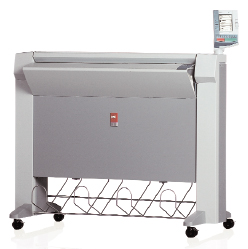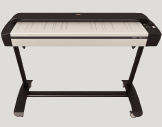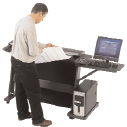Large-Format Scanners Suited for Engineering
An overview of the types of machines available and the technical specs that set these various models apart.
Latest News
May 1, 2008
By Evan Yares
 Oce North America sells a wide variety of scanners, plotters, and copiers,and is one of the vendors who sell scanners manufactured by Contex. |
Large-format scanners, capable of handling D (24 in. x 36 in.), A1 (594mm841mm), and sometimes larger documents, are not all that common a sight in engineering offices. But they should be.
Despite decades of progress in MCAD and other engineering software tools, much valuable information remains in paper form. There are untold billions of prints tucked in desk drawers, tacked to walls, or even hidden away inside of equipment cabinets on factory floors. Many of these prints include markups and revisions that have never been recorded on the official released prints.
Whether used to capture miscellaneous paper-based information within the engineering workflow, as a tool to capture markups and notes during reviews, or as part of a formal engineering document management system, large-format scanners (also called wide-format scanners) can be habit forming. Once you have one in your office, you’ll never want to give it up.
|
Large-format scanners have improved greatly through the years, yet they’ve not reached the point of becoming commodity items. While a desktop scanner might set you back as little as $50 or as much as $1,000, large-format scanners are in a whole different league, typically retailing between $10,000 to $30,000.
With that kind of money at stake, it probably makes sense to understand what sets the various models apart.
 The Ideal/Contex HD4250 scans at 600dpioptical resolution at various speeds. |
Technical specs
Unfortunately, you can’t easily compare spec sheets for large-format scanners and come to any firm conclusions about which is “best” for a particular use. There are no generally agreed-upon standards for specifications such as accuracy, throughput, dynamic range, or even, oddly enough, resolution.
One area where large-format scanner manufacturers clash is in the type of image sensors they prefer. Some claim charge-coupled device (CCD) line-scan cameras are the best. Others claim contact image sensors (CIS) are the best. As a practical matter, the differences between the two technologies are not that substantial, except in high-volume reprographic or graphic arts applications.
 The Epsom EXP1000 is a large-format flatbedscanner that supports 48-bit color scanning. |
When used in an engineering environment, the only gating specifications for large-format scanners are size and optical resolution. For uses associated with an engineering environment, optical resolutions between 400 and 600 dpi are likely to be acceptable. As of April of this year, most of the newest models of standalone large-format scanners, regardless of manufacturer, have 600 dpi optical resolution (no matter what their spec sheets may claim).
Beyond size and resolution, there is a lot of room for individual preference among different brands and models of large-format scanners. The best way to choose is to scan some of your own documents and get a feel for both the scanner hardware and software.
Colortrac
Colortrac, as you might guess from the name, is focused on the color-scanner business. It makes two lines of scanners: the SmartLF Cx series, which uses CIS technology, and the SmartLF Gx series, which uses CCD line-scan imaging technology. Both lines have 600 dpi optical resolution. (Colortrac claims 1200 dpi for the Gx series. This is a specsmanship rating. The optical resolution of the Gx series, based on the number of pixels in its cameras, is 600 dpi.)
The SmartLF Cx has a 40 in. scanning width, and is offered in monochrome, color, and express (higher speed) color models, each fully upgradeable to the next. Scan speeds are up to 9 inches per second (mono), 0.75ips (color), and 3ips (express color.)
The SmartLF Gx series includes models with 25 in., 42 in., and 54 in. scan widths, all of which are available in monochrome, color, and express color versions. (All upgradeable.) Colortrac also offers a GxT option, which supports scanning media up to 0.8 in. thick. Scan speeds on the Gx series are the same as on the Cx, except that the monochrome speed is a bit slower, at 6ips.
Generally, Colortrac recommends the Gx series for applications with critical color requirements — particularly graphic arts and photography. The Cx series is the company’s scanner of choice for the variety of uses typical to engineering environments. As the Cx series uses LED illumination (instead of fluorescent, as used in the Gx), it is better suited for portable applications, and has a lower operating cost.
Both the SmartLF Gx and Cx series, which are distributed by GEI WideFormat, include Microsoft Windows-based software for scan to file, scan to print, and scan to e-mail.
The Colortrac Gx series is also sold by Paradigm Imaging Group under the imagePro brand name.
Contex
Contex is the sales leader in the large-format scanner business. Contex and Vidar (which it acquired several years ago) were the first companies to introduce affordable (car-priced, instead of house-priced) large-format scanners.
The overall design of Contex scanners has been consistent for many years. They use multiple CCD line-scan cameras, coupled with a folded optical path, and fluorescent lighting. Despite this consistency in design, Contex scanners have been greatly refined and improved over the years.
Contex’s newest line, the HD series (available mid-April), includes sheet-fed models with scanning widths of 25 in., 36 in., 42 in., and 54 in., as well as an 18 in. x 24 in. flatbed model. These units support 48-bit color scanning (with the best 24 bits sent to the computer), and 600 dpi true optical resolution (except for the 54 in. model, which has 508 dpi optical resolution).
The HD series also features a faster USB 2.0 interface, which can transfer scans at up to 32MBps — something that becomes important with the fastest models in the line, which come in at a maximum speed of 3.0 to 12.0ips (monochrome/color).
Contex scanners support scanning to file, as well as to networks and to printers. The HD Series is compatible with most professional large-format printers, including HP, Canon, Epson, Xerox, Mutoh, and many others.
Beyond being successful at making scanners, Contex has been very successful at building strong distribution and OEM relationships. Contex scanners are sold under a variety of names, including Ideal/Contex, Océ, HP, GTCO/CalComp, and Vidar.
Graphtec
Graphtec is a nearly 60-year-old Japanese manufacturer. In the U.S., it is best known for graphics peripherals — including its line of large-format scanners.
Graphtec offers several models of scanners, all of which use CIS technology, and have 600 dpi optical resolution.
The mainstream of Graphtec’s scanner line is based on a common 42-in. platform. The IS210 is a monochrome scanner, and the CS510 and CS610 are color units, with the latter supporting thick (up to 0.8 in.) media.
All three models are available in base and pro configurations. The base configurations support maximum scanning speeds of 4.5ips (mono) and 1.5ips (color), with a maximum interpolated resolution of 800 dpi. The pro configurations support double the max scanning speeds and up to 9600 dpi interpolated resolution. All base models are field upgradeable from base to pro spec, and the IS210 is upgradeable to CS510 spec. The IS210/ CS510/CS610 are notable for including a three-year onsite warranty — which, apparently, is a reflection of Graphtec’s belief that these scanners are pretty reliable.
Graphtec sells two 36 in. color scanners. The CSX300 is a production scanner, similar to the CS510, except that it accepts media face-up instead of face-down. The SK200 is only slightly less capable. In the U.S., it is typically included as part of scan/copy/print systems; in other parts of the world it is available separately.
Graphtec scanners are included as part of scan/print/copy systems from KIP and Paradigm Imaging Corp.
Böwe Bell+Howell
B WE BELL+HOWELL sells the Infinity WF networked large-format scanner line to convert documents up to 48 in. wide into digital images with speed and accuracy. Available in three models with scanning widths of 36 in., 42 in., and 48 in., the Infinity WF is a roll-feed machine and can scan documents in bitonal, grayscale, and color at 600 dpi optical resolution. Depending on the model, it can scan at rated speeds of 3.2- to 4.2ips in color and up to 12.6ips in bitonal.
Infinity WF uses SharpShooter Trilinear CCD line-scan cameras with white LED illumination, and incorporates an integral Linux-based controller that provides network scanning (including FTP, SMB, USB, and e-mail) via a web browser.
The scanners, rated at a max of 12.4ips (mono) and 8.4ips (color), can extrapolate to 1200 dpi for extremely high-resolution images.
Infinity WF, which is designed to company specs based on the WideTEK scanner line from Image Access of Germany, features advanced paper handling and an easy-to-use feeding mechanism for oversized and delicate documents. It can be placed on a table to scan fragile documents that cannot be bent.
According to Bertl (Manalapan , NJ), an independent research and analysis lab, the WideTEK 36 has been rated as the fastest large-format color scanner on the market. And, because of its HTML-based user interface, the Infinity and WideTEK scanner lines can work in any client environment — whether Windows, Linux, Solaris, OS X, or even Vista.
Evan Yares is a consultant, analyst, pundit, developer, and user advocate, and is proud to be an engineer. He is the recipient of the 2008 CAD Society Joe Greco Community Award. You can read his blog at evanyares.com or send e-mail about this article to [email protected].
Info:
B WE BELL+HOWELL
Wheeling, IL
bbhscanners.com
Colortrac
Golden, CO
colortrac.com
GEI WideFormat
No. Canton, OH
geiwideformat.com
Graphtec
Santa Ana, CA
graphtecamerica.com
GTCO/CalComp
Columbia, MD
calcomp.com
HP
Palo Alto, CA
hp.com
Ideal/Contex
Rockville, MD
ideal.com
Image Access
Wuppertal, Germany
imageaccess.de
KIP
Novi, MI
kipamerica.com
Océ
Trumbull, CT
oce.com
Paradigm Imaging Group
Costa Mesa, CA
paradigmimaging.com
Vidar
Alleroed, Denmark
vidar.com
Subscribe to our FREE magazine, FREE email newsletters or both!
Latest News
About the Author
DE’s editors contribute news and new product announcements to Digital Engineering.
Press releases may be sent to them via [email protected].







